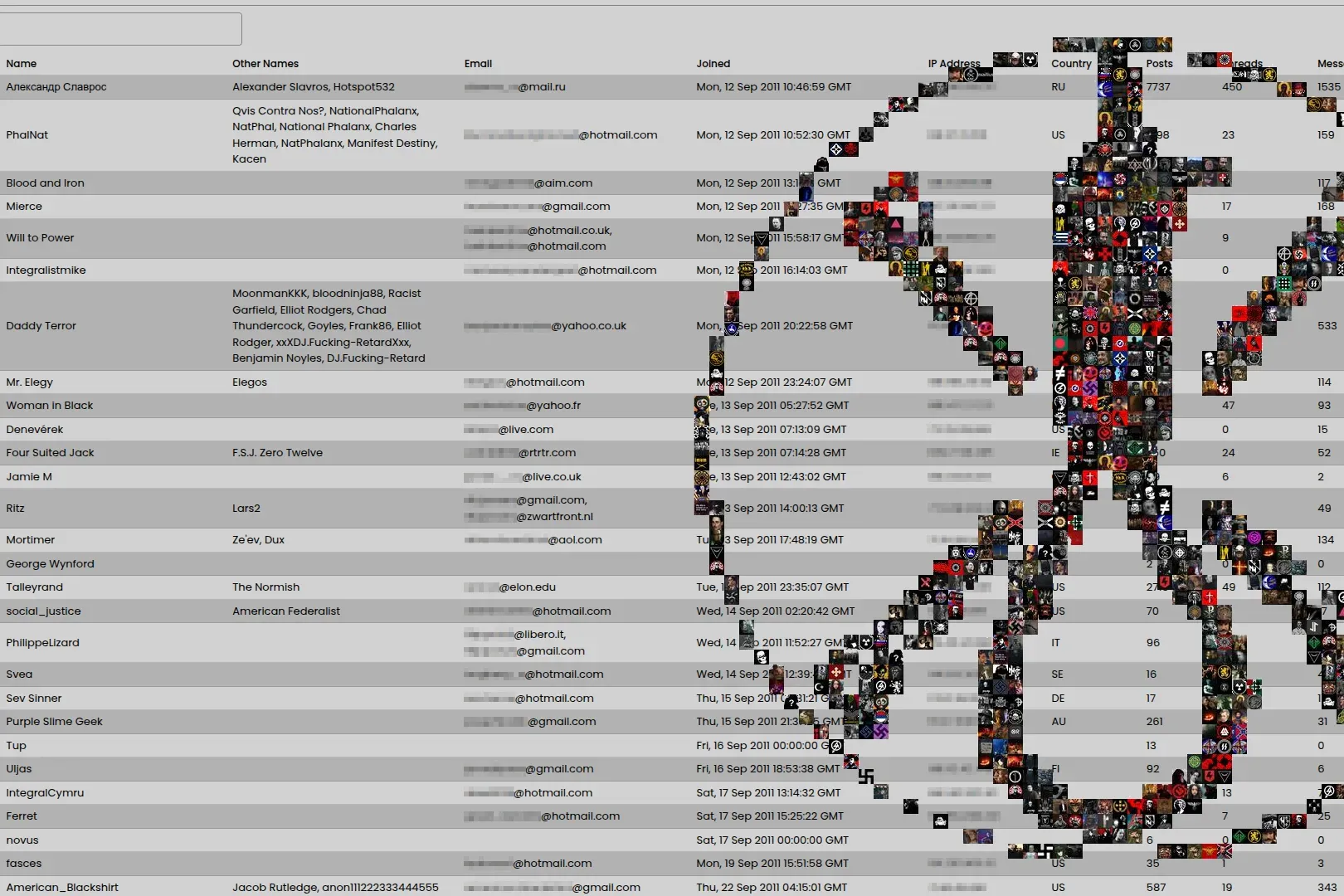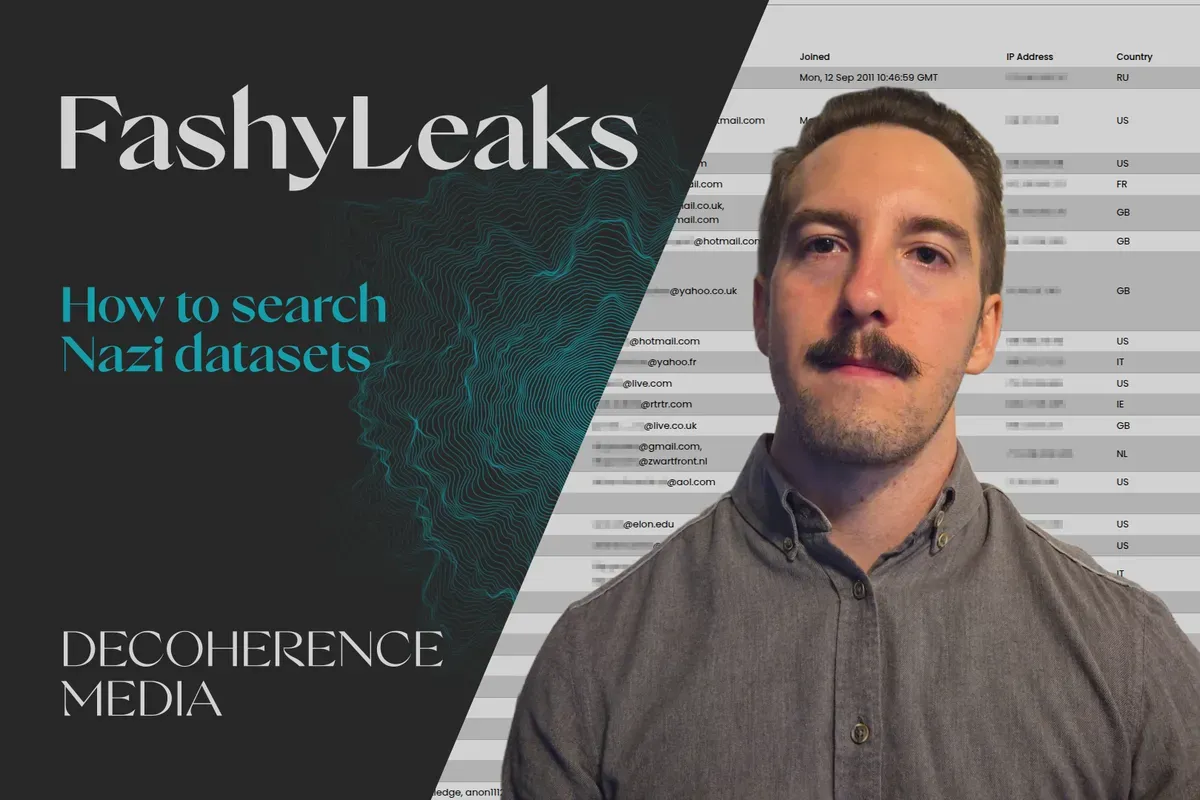As part of Decoherence Media’s article series investigating the leaked web server from the neo-Nazi online magazine Rope Culture, we’re releasing an online data interface for searching through that data, which we’re calling FashyLeaks. Besides Rope Culture, FashyLeaks also contains the Iron March database, featuring many enhancements over the original leaked version (described at the bottom of the article).
We also made a video version of this guide that you can watch.
Getting started
When you visit the FashyLeaks home page, you see a brief description of the website and 2 big buttons that link to the Iron March and Rope Culture datasets.
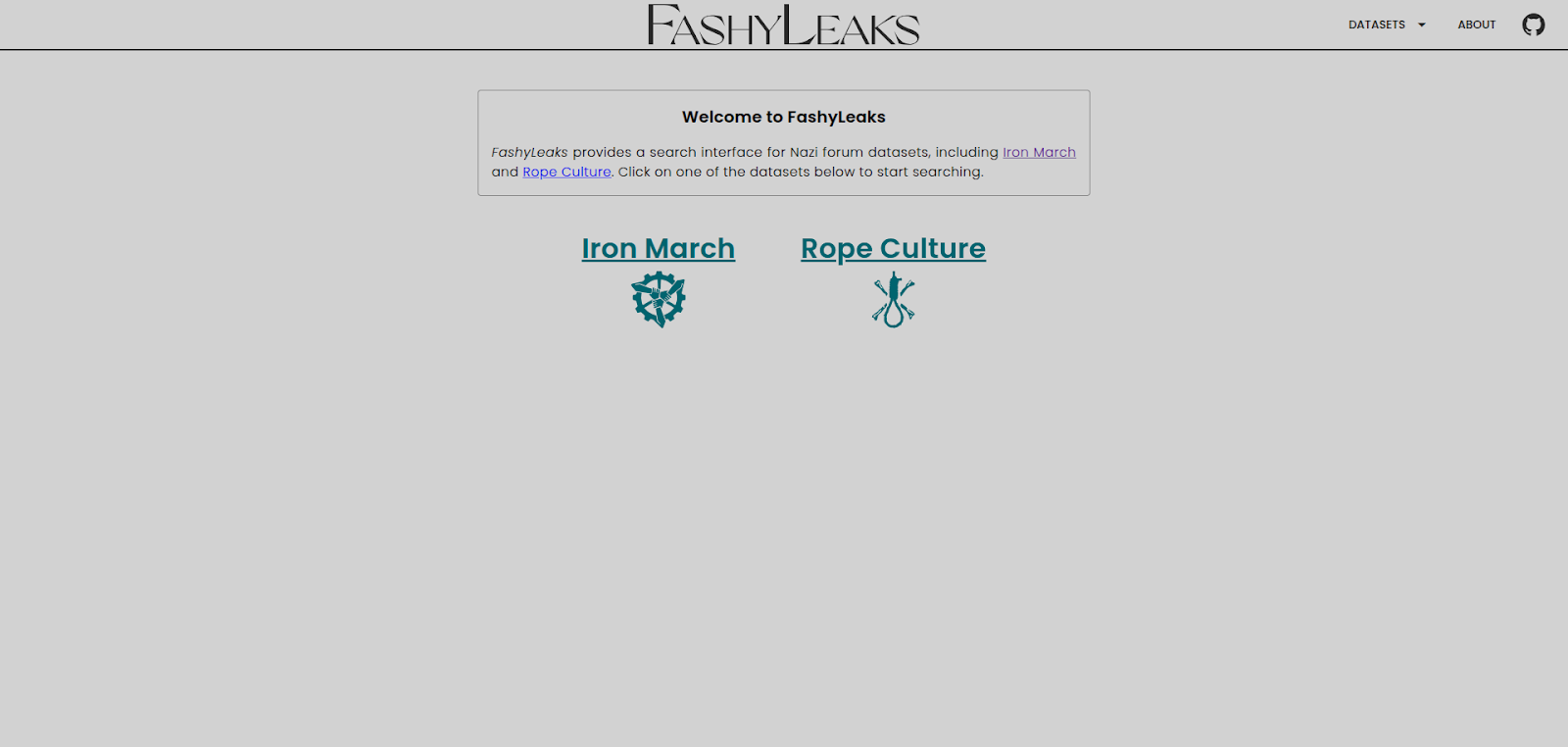
Clicking either of these buttons takes you to a page where you can search that dataset. The screenshot below shows the page for searching the Iron March dataset.
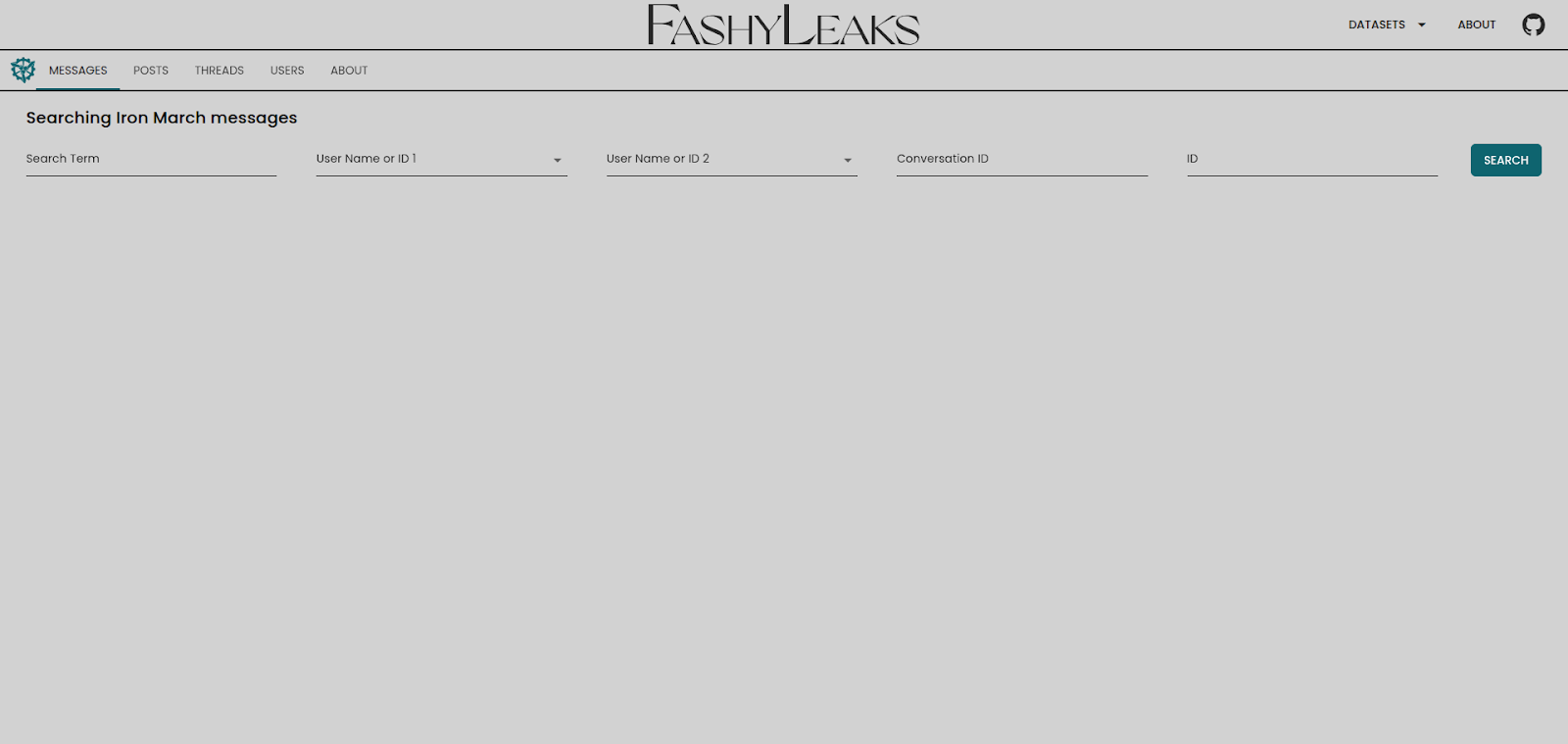
Searching messages & posts
Some terminology might be helpful here: each Dataset contains multiple Collections (lists of similar information). For example, Iron March’s collections are
- Messages (a direct message in a conversation between 2 or more users)
- Posts (a single forum post)
- Threads (a single forum thread, containing one or more posts)
- Users (an account that registered on the forum)
Similarly, Rope Culture’s collections are:
- Articles (an article, post, or announcement published on the Rope Culture website)
- Comments (a comment made on an article)
- Users (a staff member of Rope Culture; there are 11 total)
- Commenters (someone who commented on an article)
- Emails (an email message sent to or from the Rope Culture email server)
Each of these collections can be searched via one or multiple Fields.
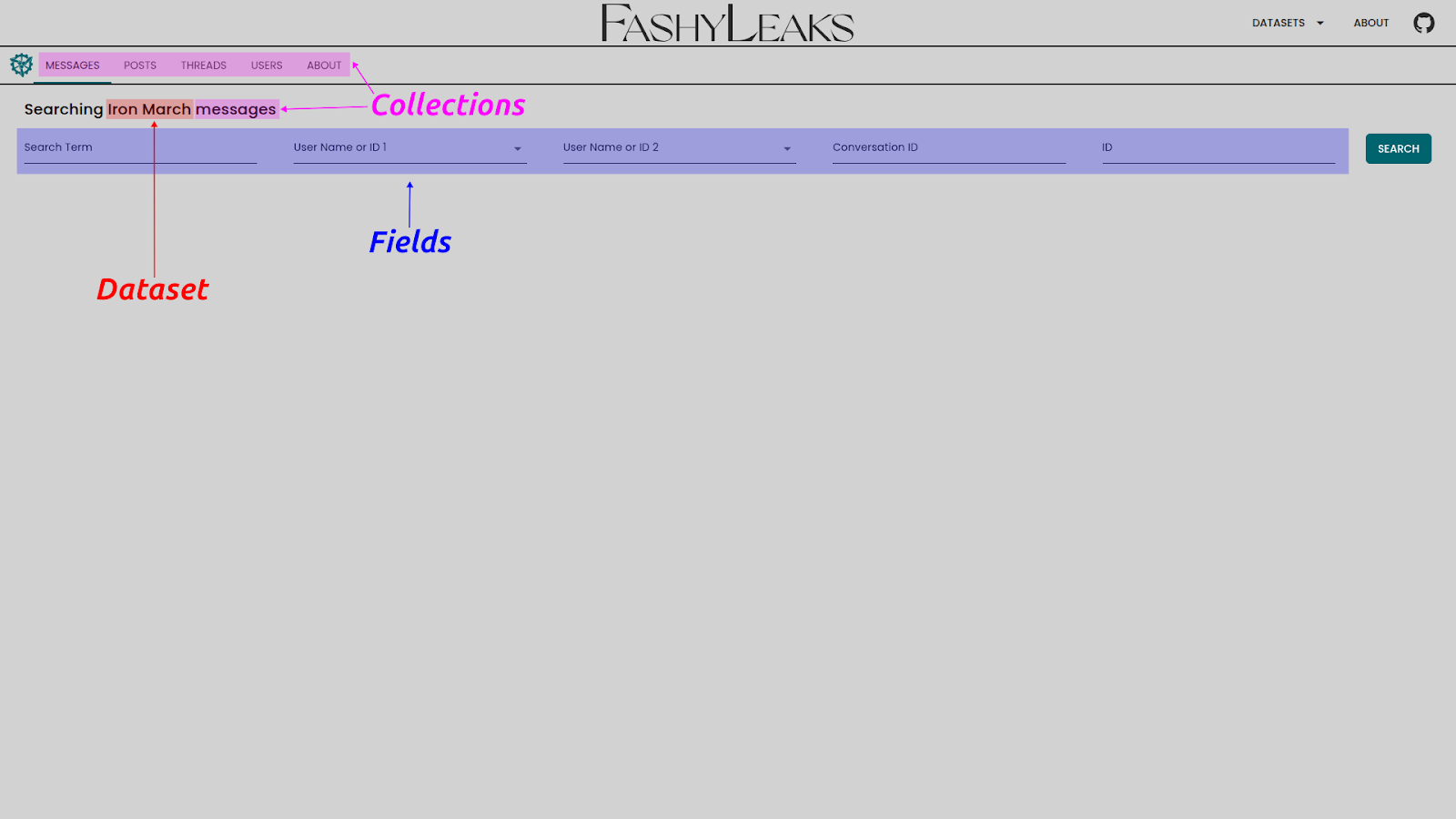
For example, you can search Iron March messages by keyword, either user, conversation ID, message ID, or any combination of those. For example, you can search for all messages between Atomwaffen Division founder Brandon Russell (“Odin”) and later Atomwaffen Division leader John Cameron Denton (“Rape”) containing the keyword “atomwaffen.”
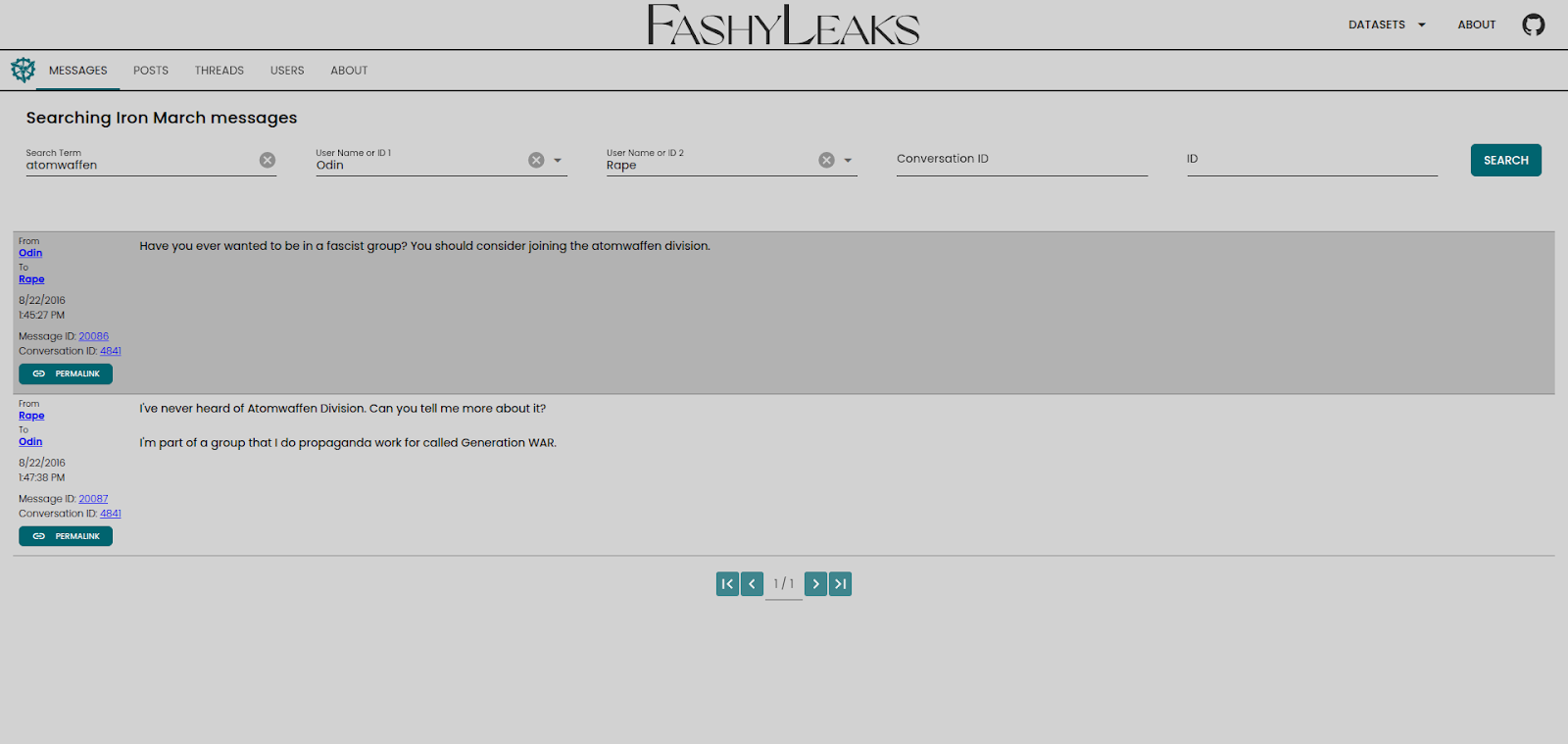
Every item in every collection (such as a single message, a single post, a single thread, or a single user) has a unique ID associated with it that comes from the leaked database. You can search by this unique ID. For example, the conversation between Brandon Russell and John Cameron Denton mentioned above has conversation ID 4831. Searching for that conversation ID shows all messages in that conversation.
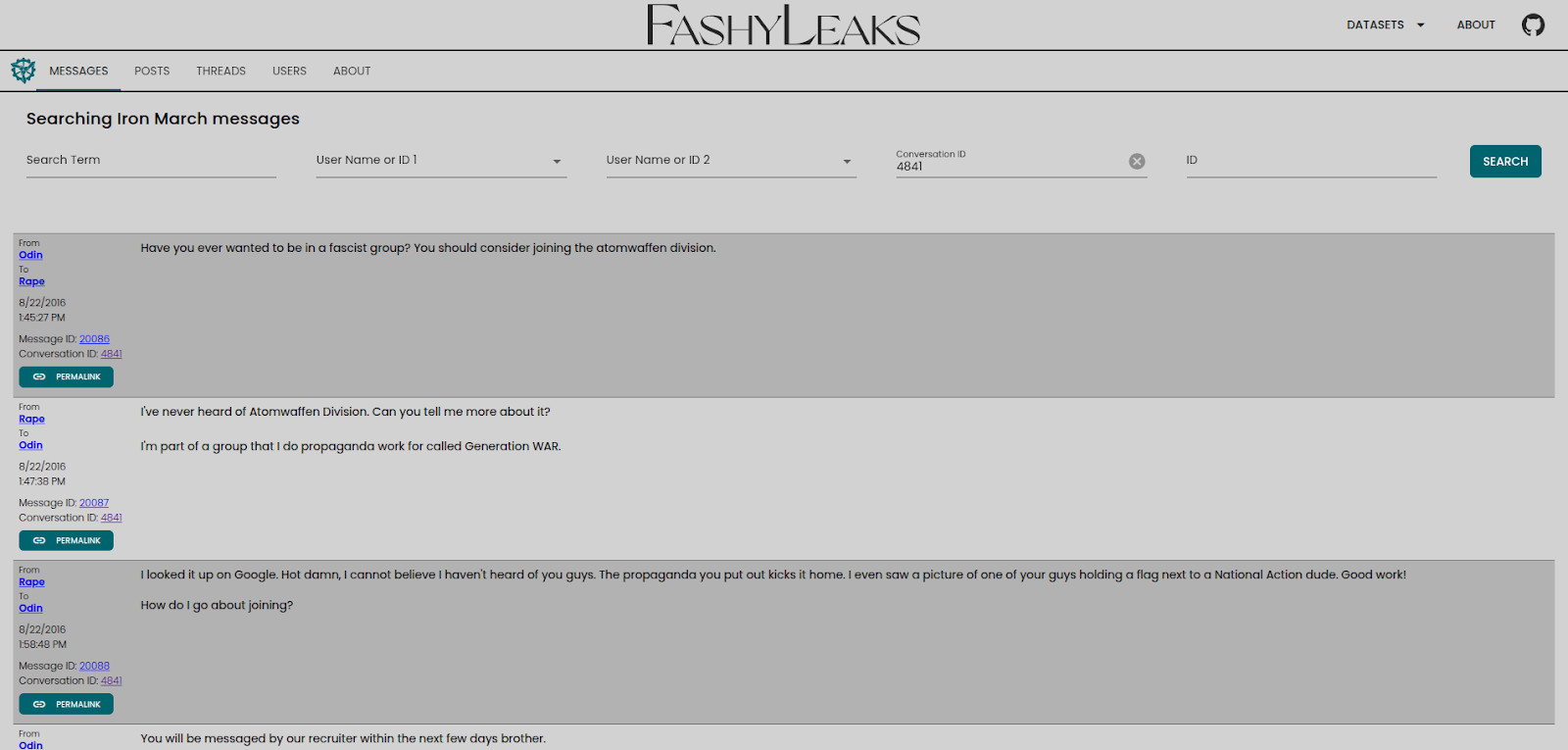
Similarly, the message that has message ID 20086 is the first message in that conversation, and you can search by that in the “ID” field.
Iron March users were encouraged to make an “introduction” post when they joined the forum. Entering “introductions” in the “Thread Category” search field in the “Searching Iron March posts” section shows all such introduction posts, and all posts made in introduction threads.
Some interesting introductions include Gabriel Sohier-Chaput’s, under the alias of “Zeiger,” and Atomwaffen Division member “Khimære”
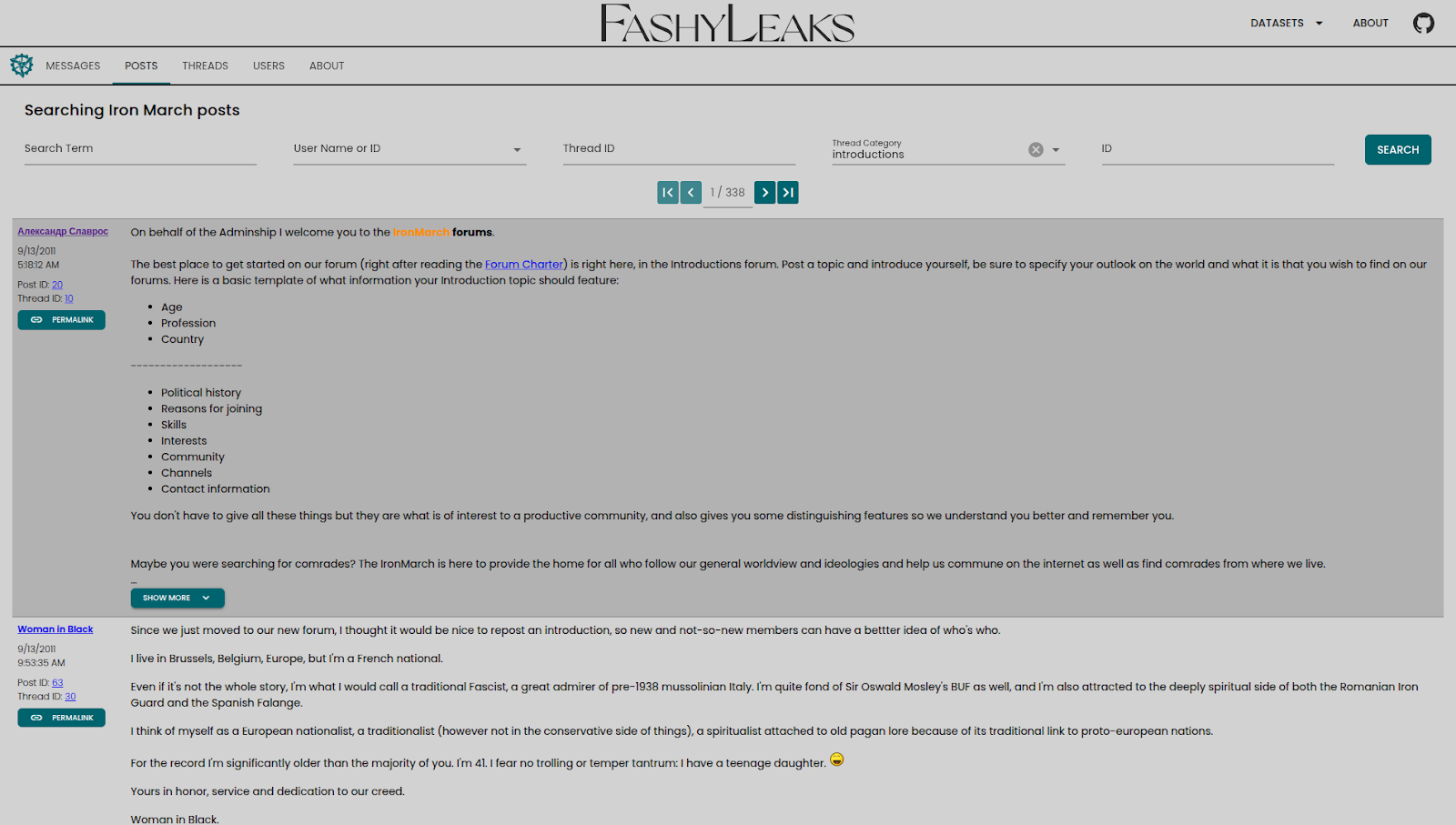
Searching users
Both Iron March and Rope Culture have one or more lists of users. For Iron March, the list comprises accounts that registered on the forum. For Rope Culture, there are two distinct lists: the Rope Culture staff that wrote the articles, and the accounts that commented on articles.
The information for these users is organized in tables, like the table of Iron March users shown below.
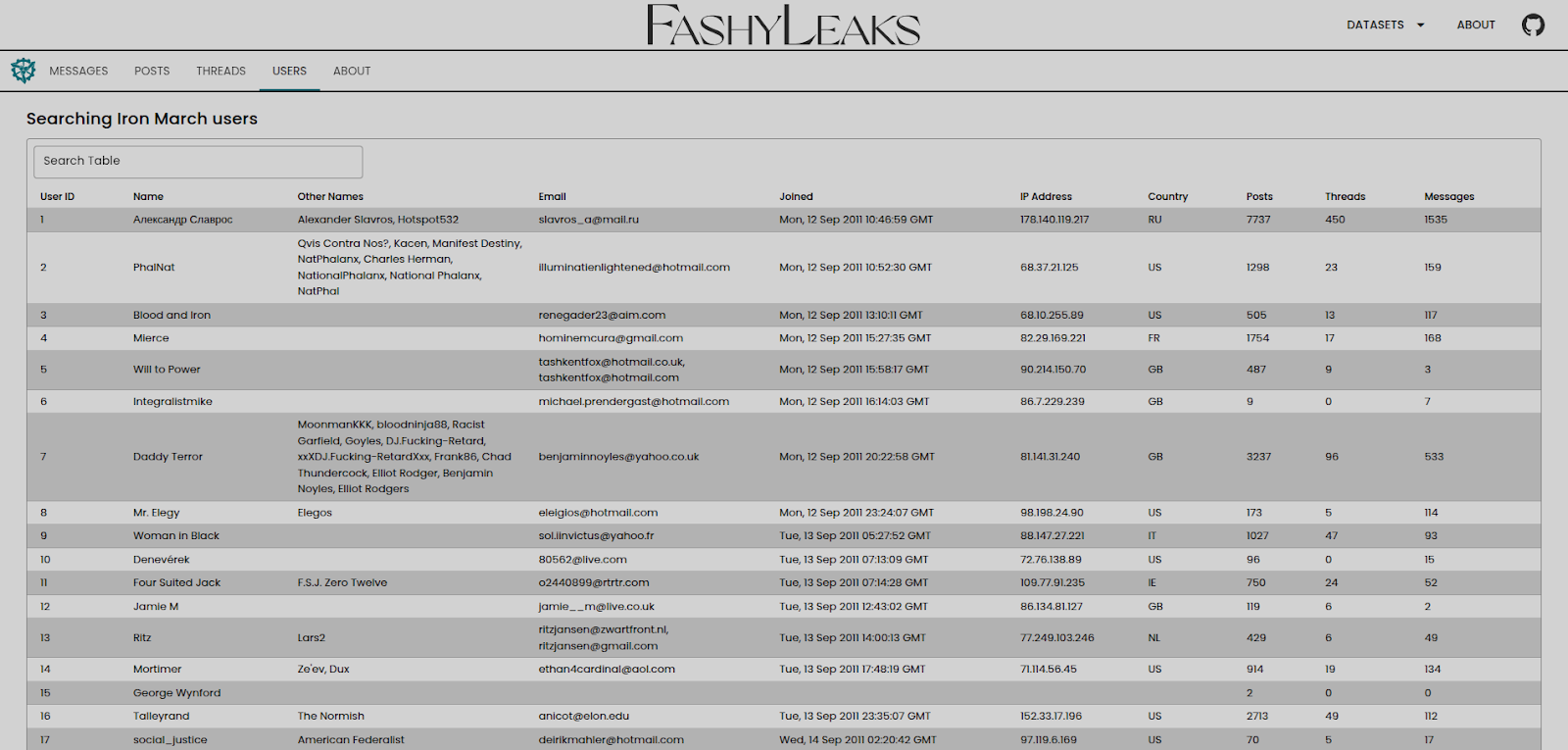
There is a lot of information, including all the usernames they used, all the email addresses they used, their primary IP address, and the country associated with that IP address.
Clicking on any of the rows in the user table takes you to a more detailed page for that user that has links to all the collections related to that user. For example, all posts, messages, and threads created by that user on Iron March. It also shows images used by that user for their profile picture, cover image, and potentially the profile picture of the email addresses they registered on the forum with. Hovering over a given image shows its source (for example, a user’s profile picture from a Wayback Machine snapshot of their page, or their email address).
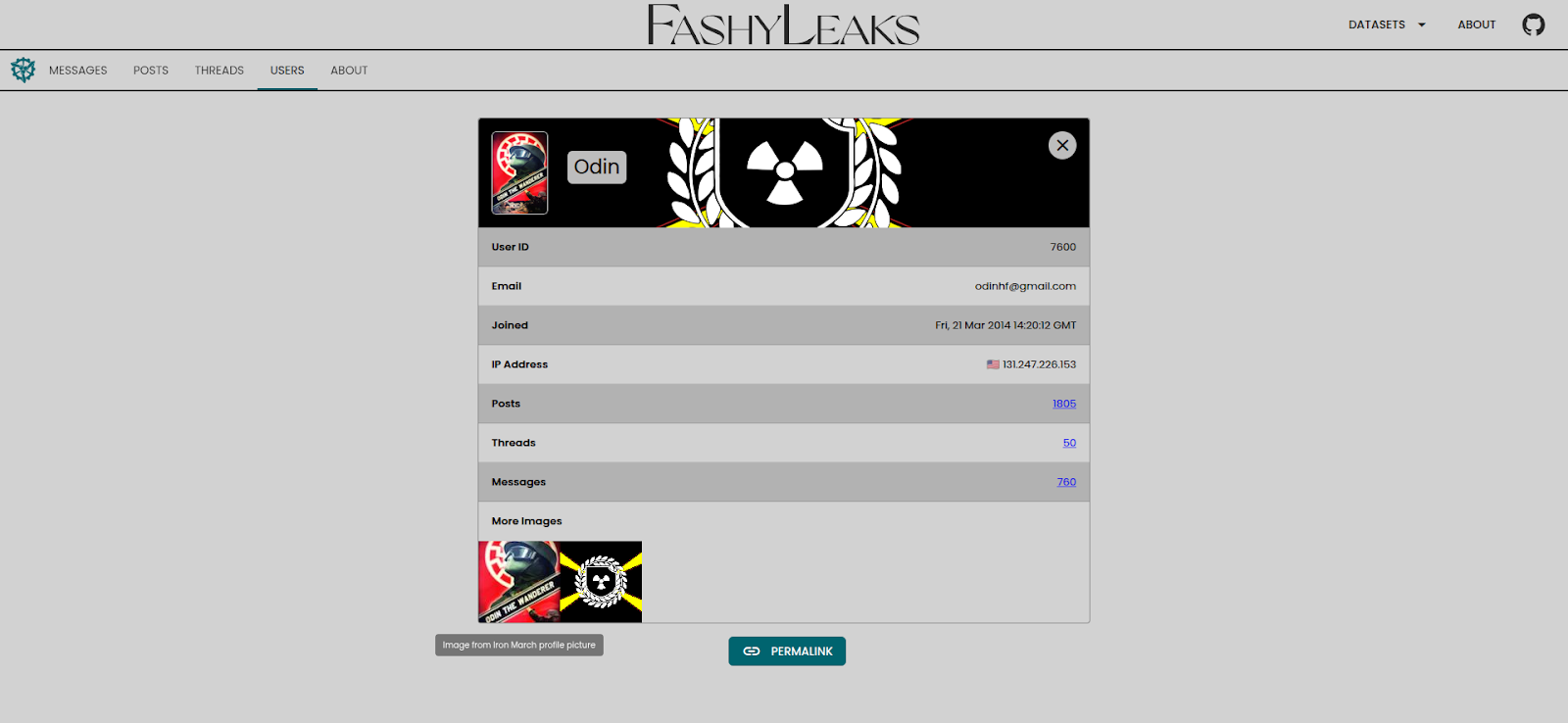
Searching Emails
FashyLeaks also provides an interface for searching through the emails from the Rope Culture’s mail server in the “Emails” collection. You can search by keyword, the email address the message was sent to or from, or the unique ID of the email message or conversation. For example, entering “[email protected]” in the “Email Address 1” or “Email Address 2” inputs shows all messages sent by Traditionalist Worker Party treasurer Max Macro to the Rope Culture admin email address ([email protected]).
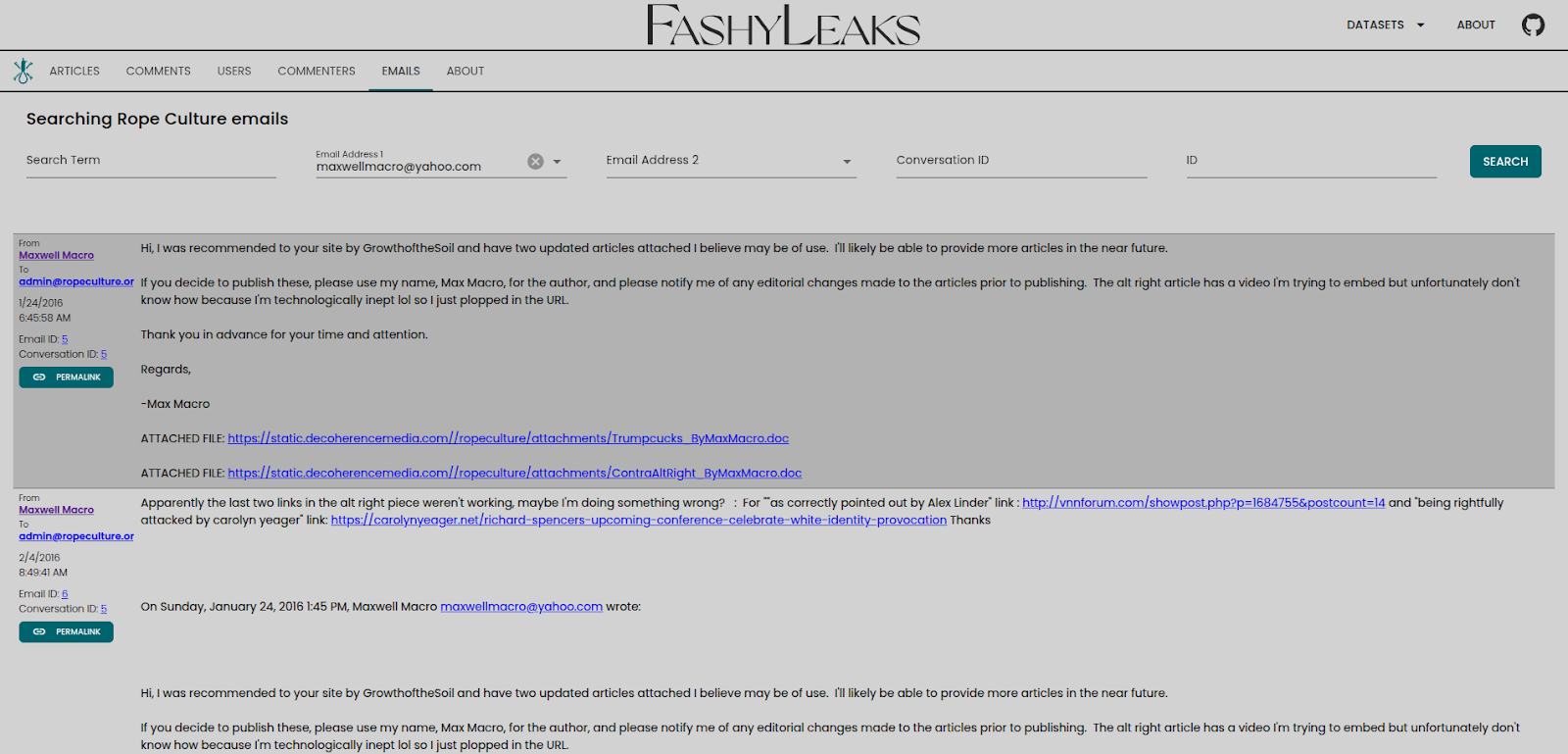
More to Explore
Search terms that readers may find interesting:
- Iron March posts about Vanguard America, the neo-Nazi organization that marched in the 2017 Unite the Right rally in Charlottesville, Virginia, that rebranded to Patriot Front. Some messages mention a “Thomas” who executed a “coup-d'etat” to take control of the organization.
- Messages between Iron March founder Alisher “Slavros” Mukhitdinov and Lindsay Souvannarath (a Canadian would-be mass shooter), who were reportedly in an online romantic relationship.
- Entering “.edu” in the Rope Culture Commenters collection shows 2 “.edu” email addresses that commented on Rope Culture articles
- Searching the term “siege” in “Posts” in the Iron March dataset returns hits to James Mason’s white power writings, compiled into a book of the same name, as early as 2011. In an “Article” from Rope Culture posted on July 25, 2017, Alisher Mukhitdinov, using the alias “Hangman,” posts about Iron March’s connection to James Mason’s book “Siege” in an article titled “James Mason Is Back!” Multiple editions of Siege were published by Iron March, and at least three editions were edited by Gabriel Sohier Chaput under the alias “Zeiger.”
- Searching “ONA” (acronym for the Nazi-Satanic cult Order of Nine Angles) in the Iron March dataset’s “Search Term” field of the “Messages” tab yields several interesting messages including from a user named Atlas who is reportedly Ryan Fleming, a pedophile who was convicted and jailed in 2017. In a 2015 message, Atlas plugs his nexion “Drakon Covenant” and describes it as a UK rendition of the US’s Tempel ov Blood (ToB), writing that both nexions follow the Order of Nine Angles and something called “Vampirism.”
Enhancements to Iron March Database
Merging Tables
The original Iron March database typically contains two versions of tables: original and core. For example, core_message_posts and orig_message_posts both contain private messages between users. The messages in the orig table range from September 2011 to March 2016, while those in the core table range from September 2011 to November 2017. Importantly, orig is not a subset of core: there are 13,341 messages in core, 21,715 messages in orig, and 594 messages that are in core but not orig.
Similarly, there are 234 posts in orig_posts that are not in forums_posts and 335 users in orig_members that are not in core_members.
Private Messages
Five percent of the private messages between users are missing one or more user IDs. And, for 22% of conversations, the first message in the conversation is missing information about the user who sent it. In many cases, these missing values can be filled-in using data from other tables in the database. One representative example is the message with msg_id 17523.
Since it’s the first message in the conversation, there’s no author information. There’s one other message in the same conversation that has an author ID (7424) that appears to be a reply to the first message. So we know who received message 17523 but not who sent it. Fortunately, there’s a table in the database called core_message_topic_user_map that has the user ID of the user who sent the first message in a conversation. This lets us know that user 11218 sent message 17523.
More Email Addresses
One of the most useful sources of information in the Iron March database was the email address of each user. Many uncareful users registered for a neo-Nazi forum using their “firstname lastname @ gmail.com” email address. It turns out another table, core_member_history, has even more email addresses from users. Every time a user changed their email address, it’s recorded in that table in a row with log_type = email_change. 63 new email addresses—which were not included in either the core_members or orig_members tables—for 49 different users, were found through this method.
Wayback Machine
We scraped every forum post and user page archived by the Internet Archive’s Wayback Machine under the domain ironmarch.org, using the Wayback Machine CDX API. Forum posts contain user data and some user profile pages contain post data. For example, user profile pages with URLs of the form “ironmarch.org/index.php?/profile/USERNAME/content” contain posts from a given user (such as this one). Processing all of these resulted in 1870 new posts and 345 new users that were not included in the original (leaked) database.
Redactions
A small number of Iron March posts and messages contained personal addresses. One post in particular contained the addresses of nearly 50 people described as “antifa” or “commies.” Additionally, not one, but two different Iron March users got into arguments via private messages and apparently sent their opponent their own address, inviting them to fight. One wrote, “Awwwwwwwwwwwww, is little bitch scared? I'll give you my address instead.” We have redacted the portions of these messages that contain such addresses.
More information
The source code for FashyLeaks’s frontend, backend, and data pre-processing can be found on Decoherence Media’s GitHub page. If you have questions about how to use it, notice a bug, or have an idea for how to improve any part of FashyLeaks, you can create an issue on our GitHub page, or contact Decoherence Media.
If you want the data itself, you can find the latest version of the FashyLeaks database here. We also have the HTML files for all Wayback Machine snapshots of all Iron March user and forum pages. Interested journalists, researchers, and organizations can contact us.


